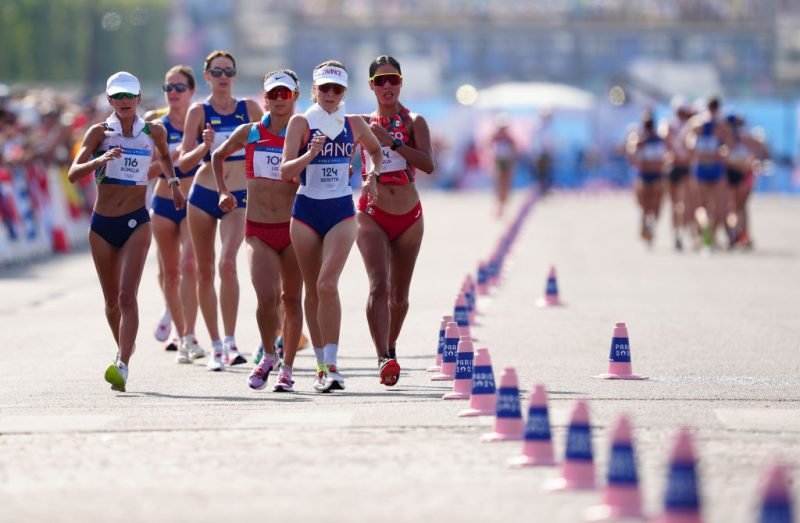(NEXSTAR) – No, the Olympians competing in this year’s race walking events aren’t “cheating” — but it sure might look like it, if you’re unfamiliar with the official rules.
Race walking was first introduced as its own Olympic event in 1908, decades after the pastime developed in Victorian England as “pedestrianism,” according to the International Olympic Committee. Several long-distance race walking events have been hosted at the Summer Games in the years since, with three separate events taking place in Paris for 2024, including a new marathon mixed relay.
The rules of race walking, one would assume, would also seem fairly obvious.
“The name of the sport itself defines the objective where participants swiftly walk their way to the finish line,” Olympics.com writes of the sport.
Competitors race during the Women’s 20km Race Walk at the Olympic Games in Paris on August 1, 2024. (Luke Hales/Getty Images)
Alas, that is not a completely accurate description of Olympic race walking. “Walking,” as defined by multiple dictionaries, involves having one foot in contact with the ground at all times. But this is not the case when it comes to Olympic race walking, as some recent viewers were surprised to discover during this year’s first few events.
“While watching the men’s 20km walk, I noticed that every single walker is ‘cheating,’” one viewer wrote in a Reddit post alongside a slow-motion video showing each competitors’ feet clearly leaving the ground before their other feet touch back down.
“Turns out that they all cheat and nobody cares?” a commenter asked. “I still don’t understand this sport.”
“I’m watching this [event] right now as well and it makes NO SENSE,” wrote yet another viewer. “They’re all literally jogging/running.”
Diego Garcia Carrera of Spain competes during the Men’s 20km Race Walk Athletics at the Olympic Games in Paris on August 1, 2024. (Alvaro Diaz/Europa Press via Getty Images)
The rules of race walking, however, are not quite as strict as these viewers had initially assumed. According to the rules — as outlined at Olympics.com — the judges overseeing the race walking events merely require one foot from each competitor to appear to be on the ground at all times “as visible to the human eye.”
“If there is no visible contact, it is deemed as ‘lifting’ and attracts a penalty,” the site adds.
There’s also another rule in place to make sure competitors are “walking” rather than jogging or running, which involves keeping the “advanced leg” straight as the athlete’s body is passing over it. Otherwise, participants can be flagged for having a “bent knee,” according to Olympics.com.
Judges along the race route will flag any violations with small yellow paddles. Multiple violations can result in penalties or disqualification, depending on the specific event.
That said, the rules of racewalking have changed over the last century. Up until 1995, the International Association of Athletics Federations (now known as World Athletics), which governs the rules for race walking for international games, had long insisted that competitors keep “unbroken” contact with the ground at all times. It was later updated to require “no visible (to the human eye) loss of contact,” as outlined in the Sport-TK Euro-American Journal of Sports Sciences.
The change may have also come about as a result of better judging tools (e.g. cameras) that picked up on the “flight phase” of the walkers’ gaits, according to RaceWalk.com, an unofficial online resource for the sport.
Competitors in the Women’s 20km Race Walk at the Paris Olympics are photographed on August 1, 2024. (David Davies/PA Images via Getty Images)
But despite the event’s strict rules or its long history at the Olympics, it’s still somewhat likely that viewers of the upcoming Marathon Race Walk Mixed Relay on August 7 will be similarly confused by the sport.
“The way I see it, it is basically competition of who can cheat the most without getting caught,” one social media user said. “It is [an] entirely flawed sport.”
